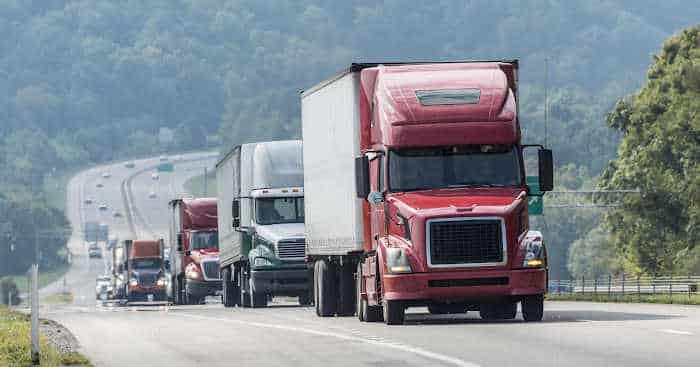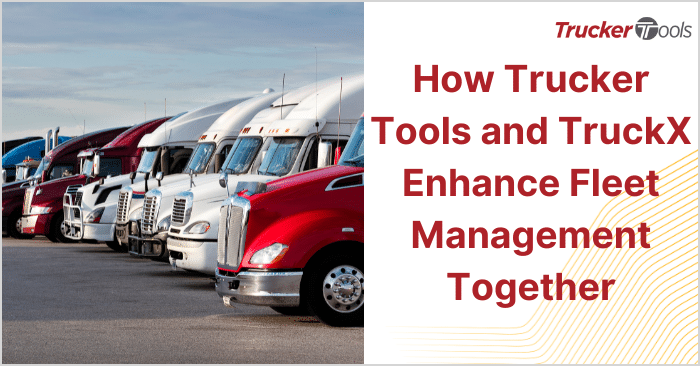With 2021 soon coming to a close, now is the time to be thinking about your strategy for ensuring 2022 is a successful year for your freight broker business. According to most industry analysts, current freight conditions including higher than normal rates and extremely tight capacity are here for the foreseeable future. Other factors such as port congestion, a tight labor market and raw material shortages aren’t likely to ease up any time soon, either. With this in mind, we’ve put together a list of the top 10 ways that you can use technology to scale up and expand your freight broker business in 2022 and beyond, despite the challenges that the industry is likely to face.
1. Save Time, Resources with Real-Time Digital Load Tracking
With real-time digital load tracking, your team doesn’t need to call or text a driver or dispatcher to find out where the shipper’s load is located and when it’ll arrive at its next stop. Instead, team members can view the real-time location of loads directly in your transportation management system. You also can automatically share visibility data with shippers to further reduce manual communications and increase operational efficiency.
2. Offer Drivers BOL/POD Document Upload
When drivers use the Trucker Tools driver app for load tracking, at the end of the track when they reach the final destination, they’re prompted to upload and send you digital versions of POD and BOL documents. BOL/POD doc upload capabilities streamline your process for paying carriers, which ultimately makes your business more efficient. Greater operational efficiency often translates into the ability to up your load count without increasing your employee headcount.

3. Reduce Check Calls
Brokers and 3PLs that implement digital load tracking solutions like Trucker Tools’ real-time visibility platform are able to reduce or even eliminate check calls. Reducing or eliminating manual check calls frees up members of your track and trace team to stay ahead of service delays and provide a higher level of service to your shipper customers, which helps you retain current customers and cultivate new ones.
4. Increase Productivity with Digital Freight Matching
With digital freight matching platforms like Trucker Tools’ Smart Capacity, your team can determine where capacity is likely to be available with a few mouse clicks. Unlike load boards, the capacity data that you see in digital freight matching platforms like Smart Capacity is based on the real-world movement of trucks and transactions between brokers and carriers. Digital freight matching reduces the number of phone calls you make to carriers and can eliminate the need to use load boards.
5. Boost Carrier Utilization
The beauty of digital freight matching software like Smart Capacity is that when you search for capacity, you can restrict your search to carriers who have already been onboarded with your brokerage. Re-using already-onboarded carriers allows your team members to cover loads faster because they don’t have to onboard a new carrier every time a load needs to be covered. It also helps you build long-term relationships with high-performing carriers, which is key if you want to grow your business in 2022.

6. Target Your Outreach to Carriers
One of the reasons that digital freight matching technology’s popularity has grown so quickly is that it allows you to target your communications to specific carriers. When your team members use a digital freight matching platform like Trucker Tools’ Smart Capacity, they can do a quick search of the platform to find out which carriers are likely to have capacity in the lane and on the date they need. Instead of calling every carrier on your list, they can target their communications only to those carriers who are likely to have the capacity they need, which makes your process for finding capacity much more efficient.
7. Shorten the Rate Negotiation Timeline with Digital Load Booking
Negotiating rates by phone is an inherently inefficient process. To secure capacity manually, first a member of your team has to reach the carrier dispatcher by phone and find out if they have a truck available. Once they do, then they must negotiate the rate with the carrier and then schedule the appointment in your TMS. Imagine instead that you post your loads with rates in a digital marketplace where carriers can book your loads digitally. When the carrier books the load, it’s automatically recorded in your TMS. That’s what Trucker Tools’ Book-It-Now® can offer.
8. Streamline Workflows for Employees
Using technology such as real-time load tracking, digital freight matching and automated load booking simplifies workflows for your employees. When team members don’t have to make dozens of phone calls to carriers to track loads or secure capacity, they have more time to broker more freight volume, which can increase your revenue. If your process for tracking loads and securing capacity is purely manual and repetitive, the only way that you can broker more freight is by hiring on new employees.

9. Automate Repetitive Manual Processes
In a tight labor market like the current one, you also want your employees to stay with your company and the truth is that no one wants to make 10 phone calls to track a single load or to call carriers over and over to ask them if they have capacity. Let technology do the heavy lifting when it comes to load tracking and capacity procurement. Doing so allows you to focus your human resources on relationship-building with carriers and shippers, which is more meaningful work for your employees.
10. Deepen Carrier Relationships
All of the different types of technology we’ve mentioned thus far also can help you build stronger relationships with carriers. Fleet owners strive for greater efficiency in their operations, just like you do. They recognize that greater efficiency can equal higher revenue. Using technology that reduces the number of phone calls their team has to answer, that allows their team to book your loads digitally and that lets you track loads without bothering the driver can go a long way in making you a broker of choice with carriers. To find out how the pandemic is reshaping trucking and freight brokerage, be sure to read State of the Industry: How the Trucking Industry Is Adapting to Unprecedented Disruption. Schedule a free demo of Trucker Tools’ real-time load tracking, Smart Capacity digital freight matching platform and Book-It-Now®.






